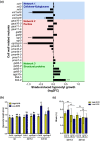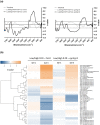Pectin methylesterification state and cell wall mechanical properties contribute to neighbor proximity-induced hypocotyl growth in Arabidopsis
- PMID: 38646567
- PMCID: PMC11033045
- DOI: 10.1002/pld3.584
Pectin methylesterification state and cell wall mechanical properties contribute to neighbor proximity-induced hypocotyl growth in Arabidopsis
Abstract
Plants growing with neighbors compete for light and consequently increase the growth of their vegetative organs to enhance access to sunlight. This response, called shade avoidance syndrome (SAS), involves photoreceptors such as phytochromes as well as phytochrome interacting factors (PIFs), which regulate the expression of growth-mediating genes. Numerous cell wall-related genes belong to the putative targets of PIFs, and the importance of cell wall modifications for enabling growth was extensively shown in developmental models such as dark-grown hypocotyl. However, the contribution of the cell wall in the growth of de-etiolated seedlings regulated by shade cues remains poorly established. Through analyses of mechanical and biochemical properties of the cell wall coupled with transcriptomic analysis of cell wall-related genes from previously published data, we provide evidence suggesting that cell wall modifications are important for neighbor proximity-induced elongation. Further analysis using loss-of-function mutants impaired in the synthesis and remodeling of the main cell wall polymers corroborated this. We focused on the cgr2cgr3 double mutant that is defective in methylesterification of homogalacturonan (HG)-type pectins. By following hypocotyl growth kinetically and spatially and analyzing the mechanical and biochemical properties of cell walls, we found that methylesterification of HG-type pectins was required to enable global cell wall modifications underlying neighbor proximity-induced hypocotyl growth. Collectively, our work suggests that plant competition for light induces changes in the expression of numerous cell wall genes to enable modifications in biochemical and mechanical properties of cell walls that contribute to neighbor proximity-induced growth.
© 2024 The Authors. Plant Direct published by American Society of Plant Biologists and the Society for Experimental Biology and John Wiley & Sons Ltd.
Conflict of interest statement
The authors did not report any conflict of interest.
Figures





Similar articles
-
TCP Transcription Factors Regulate Shade Avoidance via Directly Mediating the Expression of Both PHYTOCHROME INTERACTING FACTORs and Auxin Biosynthetic Genes.Plant Physiol. 2018 Feb;176(2):1850-1861. doi: 10.1104/pp.17.01566. Epub 2017 Dec 18. Plant Physiol. 2018. PMID: 29254986 Free PMC article.
-
Mechanochemical feedback mediates tissue bending required for seedling emergence.Curr Biol. 2021 Mar 22;31(6):1154-1164.e3. doi: 10.1016/j.cub.2020.12.016. Epub 2021 Jan 7. Curr Biol. 2021. PMID: 33417884
-
Tuning of Pectin Methylesterification: PECTIN METHYLESTERASE INHIBITOR 7 MODULATES THE PROCESSIVE ACTIVITY OF CO-EXPRESSED PECTIN METHYLESTERASE 3 IN A pH-DEPENDENT MANNER.J Biol Chem. 2015 Sep 18;290(38):23320-35. doi: 10.1074/jbc.M115.639534. Epub 2015 Jul 16. J Biol Chem. 2015. PMID: 26183897 Free PMC article.
-
Tuning of pectin methylesterification: consequences for cell wall biomechanics and development.Planta. 2015 Oct;242(4):791-811. doi: 10.1007/s00425-015-2358-5. Epub 2015 Jul 14. Planta. 2015. PMID: 26168980 Review.
-
Plant Responses to Vegetation Proximity: A Whole Life Avoiding Shade.Front Plant Sci. 2016 Feb 29;7:236. doi: 10.3389/fpls.2016.00236. eCollection 2016. Front Plant Sci. 2016. PMID: 26973679 Free PMC article. Review.
References
-
- Alonso‐simón, A. , García‐angulo, P. , Mélida, H. , Encina, A. , Álvarez, J. M. , & Acebes, J. L. (2011). The use of FTIR spectroscopy to monitor modifications in plant cell wall architecture caused by cellulose biosynthesis inhibitors. Plant Signaling & Behavior, 6, 1104–1110. 10.4161/psb.6.8.15793 - DOI - PMC - PubMed
LinkOut - more resources
Full Text Sources

